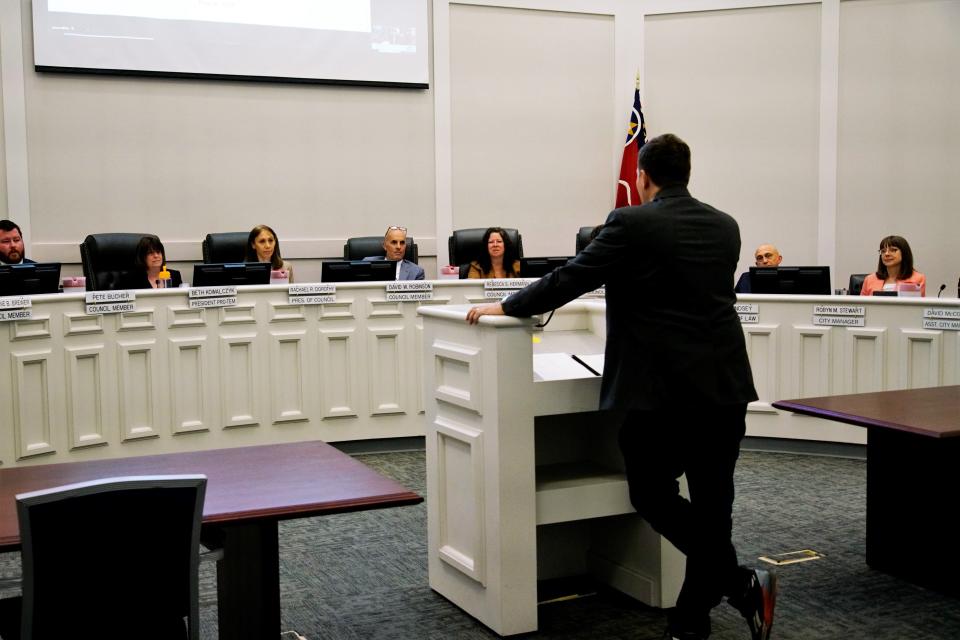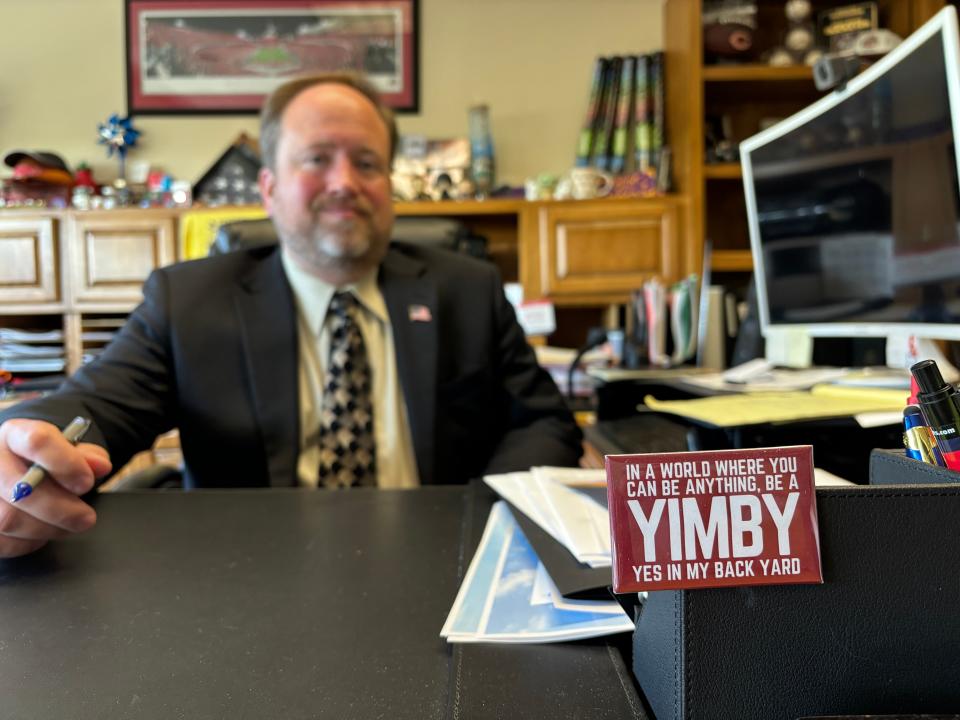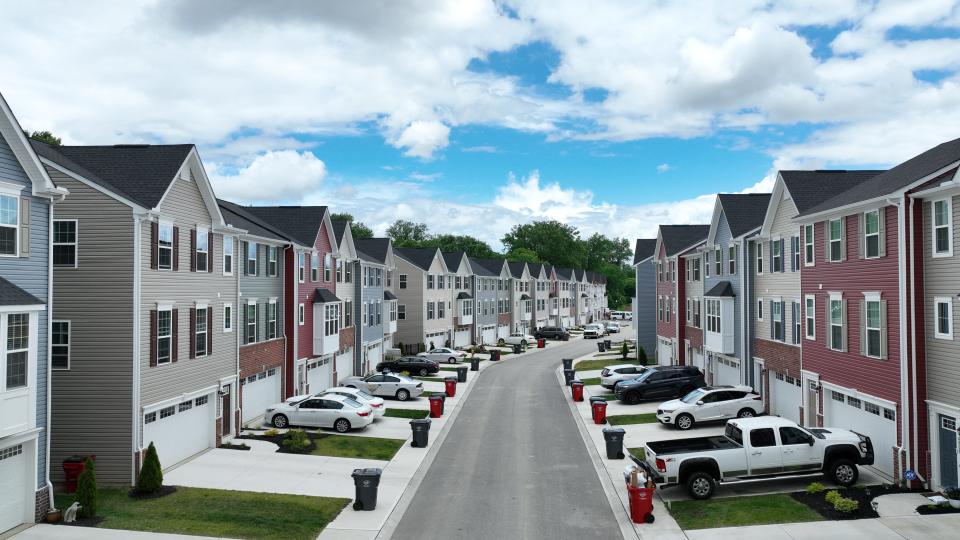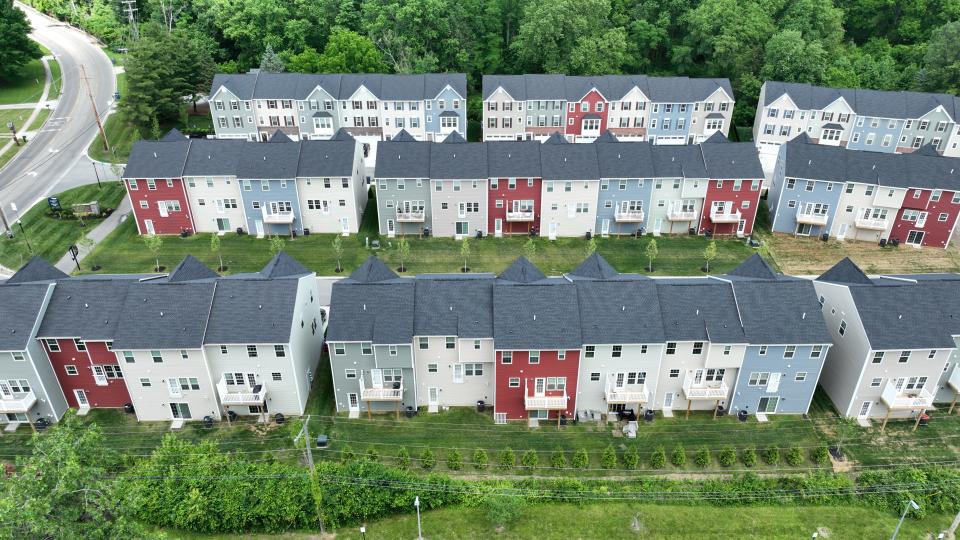Some suburbs joining Columbus in rezoning to fight housing crisis - others, not so much
“I am unsurprised by these findings,” Worthington resident Aaron Shearer said of a housing needs assessment consultants presented to the Worthington City Council that found a strong demand for more and diverse housing.
“These (findings) are pretty much everything I've come to Council and presented to you for about two years," said Shearer, the founder of the community group Worthington Inclusive Solutions and Engagement or WISE Worthington.
Area advocates for more housing, like Shearer, as well as Columbus city leaders, have long preached that Columbus alone cannot address the region’s dire need for more housing and the suburbs must do their part.
A frequent flyer during public comment sessions, Shearer urged the Council at a late May meeting to change the city’s zoning code to allow for more housing. He said he finds it concerning that the Council won’t take a simple step like legalizing accessory dwelling units — a smaller, second living unit added on the same property as a house. It's a step that has been proposed numerous times, including by the Building Inclusive Communities initiative, which Worthington commissioned.

Updating zoning codes, similar to what Columbus is doing, could go a long way, according to experts like Glennon Sweeney, a city and regional planning doctoral candidate at Ohio State University's Knowlton School of Architecture.
Sweeney is researching which central Ohio municipalities have the most exclusionary zoning codes that prevent development. Every local municipality is exclusionary, she said, according to her research for her dissertation.
Central Ohio should be building 14,000 to 19,000 homes and apartments annually to meet demand, according to a 2022 report by the Building Industry Association of Central Ohio. And Franklin County should be building between 8,000 and 16,000 of those units. But the region has only constructed about 10,000 units annually in recent years, with Franklin County issued permits for about 7,300 units last year.
Many suburban leaders told The Dispatch they’re taking the need for more housing seriously. But dedication to change in Franklin County is a mixed bag, according to Sweeney.
Alongside Columbus, Reynoldsburg and Whitehall have led the charge, overhauling their zoning codes in 2020 and 2023, respectively, to allow for more development. Reynoldsburg has seen some dividends with 3,500 units at various price points approved in the past four years, Mayor Joe Begeny said.
Gahanna updated its code earlier this year, and Hilliard and Grove City are about to. However, the degree to which each municipality’s changes or proposed changes provide for more housing varies.
Several other suburban cities, including Worthington, Upper Arlington, Bexley and Westerville, are discussing housing — a lot recently, even though they haven't changed their zoning practices. They’re bringing in speakers, forming committees, updating their codes in a piecemeal way, or taking steps unrelated to zoning to encourage more housing.
Why housing advocates want zoning reform
Since the 1950s, municipalities nationwide have used zoning to require things like large swaths of only single-family homes on large lots to keep poorer and minority residents out, according to Richard D. Kahlenberg, author of "Excluded: How Snob Zoning, NIMBYism, and Class Bias Build the Walls We Don’t See."
The resulting economic segregation hinders social mobility by keeping poorer and minority individuals from opportunities like better public schools, according to Kahlenberg.
“The worst offenders tend to be in the suburbs. That’s what I found for the Columbus region,” said Kahlenberg said. “I think Columbus acting on its own is necessary but not sufficient to address the problem. … It would be a shame if the suburbs didn’t join Columbus in the effort for reform.
“It would be better if the exclusionary barriers came down in high-opportunity neighborhoods that offer really strong schools,” Kahlenberg said.
Kahlenberg said zoning reformists are trying to accomplish two things: increase housing supply so prices stabilize for everyone and reduce economic and racial segregation.
This is also an economic issue, as employers want their employees to be able to live close to work, Kahlenberg said.
Columbus-area developers have long harped that zoning is the region’s largest barrier to building but others disagree. For one, Dan Ralley, Hilliard assistant city manager and community development director, said building out infrastructure like water and sewers is a larger barrier in Hilliard.

Reynoldsburg and Whitehall lead charge
Begeny, Reynoldsburg's mayor, has a small red sign on his desk that says, “In a world where you can be anything, be a YIMBY. Yes in my backyard.”
It’s a response to the phrase ‘not in my backyard’ or NIMBY, a term commonly used to describe residents who oppose development in their neighborhood.
Begeny said he can’t take credit for the slogan.
“That’s stolen from Whitehall,” Begeny said. “Mayor (Kim) Maggard and now Mayor (Michael) Bivens, that’s been one of their slogans.”
Begeny said the region is not even close to building enough housing because “of the exact opposite of what Reynoldsburg is doing. Reynoldsburg is finding ways to make it as easy as possible ... to develop here.”
In 2020, Reynoldsburg changed its zoning code to make more types of housing, like townhomes or apartments, allowable in more parts of the city.
Begeny believes zoning changes directly led to development like the two townhome developments Ryan Homes built in the city in recent years. The Woodmont Trace Townhomes off Rosehill Road built in 2022 sold in the $300,000s, and the Wilson Ridge development off South Wagoner Road built this year has homes starting at around $290,000.

“Any housing is going to benefit us,” Begeny said. “Obviously I think the priority should be affordable housing, but having options opens your house for other people."
In 2023, Whitehall also updated its zoning code to be more user-friendly and encouraging of housing development. The new code allows for four or five stories in many corridors and in three denser nodes, allowing up to 12-story buildings. The code also simplifies seven residential categories to two: multi-unit districts (like apartment buildings) and areas for single-unit homes. But the latter also allows for duplexes and accessory dwelling units.
“The idea is not to fundamentally change the character of neighborhoods but just to diversify the housing types and then in certain corridors, significantly densify,” said Jason Sudy, of OHM Advisors who helped Whitehall with updating its code.
What other suburbs are doing — or not doing
Ralley said Hilliard is already doing its part in terms of the number of units built every year relative to its size in the county. The community plan Hilliard adopted last year calls for encouraging a wider range of housing types and highlights five focus areas in the city where they could encourage development and redevelopment.
Ralley hopes the city will pass zoning code changes for each of the five focus areas over the next year. He expects four of those areas, including around Interstate 270, will include more flexible zoning for more uses like housing, including townhomes or “missing middle housing.”
The city plans to prioritize encouraging development with a mix of uses like offices, retail and housing. Ralley pointed out that single-use residential developments can be a financial drain on cities as many cities get most of their funds from workers paying income taxes.
Grove City is in the early stages of working on modernizing its zoning code, which was last updated in the 1970s, said Development Director Kyle Rauch. Like Columbus, Grove City is trying to remove barriers to getting a project approved by producing a new zoning code that’s understandable and reduces red tape.
Grove City wants to be strategic about establishing where denser residences can be built because only some corridors’ infrastructure (roads, sewer, etc.) can accommodate more people, Rauch said.
The city will start public engagement on zoning reforms soon, Rauch said.
Gahanna City Council passed a new zoning code in April. For instance, in multifamily zones, the maximum density rose from 18 units per acre to 25 units per acre. The new code also makes it easier to get housing development approved in a business district.
“It's said in the economic development world that for every one job you add, you have to add a housing unit,” Gahanna Mayor Laurie Jadwin said.
Gahanna’s neighbor, New Albany doesn’t see it the same way.
"For us, it’s not as formulaic," said Jennifer Chrysler, New Albany director of community development. "It’s more about how these land uses balance one another and really planning for quality of life for the residents who live here, but also the employees who work here.”
New Albany expects its business park to grow to employ 25,000 people, including at Intel. Asked about building housing for any of those workers, Chrysler said the average commute in the Midwest is more than a half hour and workers can pick where they live. She said New Albany is focused on providing balanced options from traditional single-family communities to multifamily housing in the village center.
Sweeney said suburbs like Dublin and New Albany are not interested in economic diversity and resist affordable projects.
Chrysler said the market drives real estate prices and the city does not have any policies that preclude lower-cost or subsidized housing.
Dublin Director of Community Planning and Development Jennifer Rauch said in an email: “Through the City’s comprehensive housing study, we have demonstrated our commitment to ensuring housing options that support the needs of Dublin's employment base and all populations within the City. Similarly, our Envision Dublin community plan update supports the recommendations of the housing study, and includes a chapter solely focused on housing and neighborhoods.”
Begeny said every community is going to handle the issue different and he wants Reynoldsburg to be a place where everyone — including teachers, police officers, and his favorite local coffee shop’s employees — can live and work.

This article originally appeared on The Columbus Dispatch: Reynoldsburg, Whitehall leading rezoning charge among Columbus suburbs

